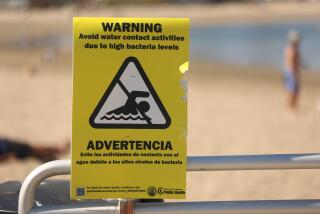ON THE WATERFRONT
- Share via
MALIBU — This is Hell Week in the most heavenly of settings.
The water temperature is a pleasant 63 degrees, the surf is one to three feet and the pristine white sand of Zuma Beach feels cool and comfortable as more than 90 boys and girls ages 9-17 begin training in the Los Angeles County Junior Lifeguard program.
There was plenty of huffing and puffing Tuesday morning after a brisk beach run and three quick trips into the water. But no one dropped out, no one needed mouth-to-mouth resuscitation and no one complained about spending the next six weeks of summer vacation at the beach.
Ashley Grashaw, 15, a soccer player at Chaminade High, is already hearing grumbling from her envious friends.
“The girls on my soccer team like the lifeguard at tower No. 7, so they’re jealous I’m here,” she said.
Chris Austin, a water polo and baseball player at Thousand Oaks, knows exactly what he’s in for.
“You learn stuff, you get in way good shape and you get to work on your tan,” he said.
What a life. Go to the beach at 8:30 a.m. Run a mile, or sometimes three miles, along the sand. Swim once or twice around a buoy. Go surfing. Learn about riptides, CPR, first aid, identifying shock and heart attack victims. Dream about a Pamela Anderson sighting.
“It’s a pretty neat program for kids,” said lifeguard Craig Rond, who coaches swimming and water polo at Thousand Oaks. “I encourage every kid in our program [to join].”
It’s the 39th year for Junior Lifeguard classes in Los Angeles County. More than 2,000 boys and girls are enrolled at beaches from Catalina Island to Zuma. The cost is $267 and scholarships are awarded to underprivileged kids. Each participant had to pass a swim test. Teenagers were required to swim 100 yards in no more than 90 seconds.
Many of the boys and girls play on sports teams. By early August, they’ll be in such good shape that their coaches might want to make Junior Lifeguard classes mandatory for all of their athletes.
Joey Rodriguez, a wide receiver at Granada Hills, can’t wait until co-coaches Tom Harp and Darryl Stroh try to tire him at football practice next month. He’ll be ready to keep going and going like a rechargeable battery.
“It will help with my endurance,” Rodriguez said of the lifeguard training.
If Harp or Stroh ever start feeling ill during a game, Rodriguez is prepared to offer immediate help because of his CPR training.
“It’s cool,” he said.
For first-timers, Rond offered a sobering warning during stretching exercises Tuesday.
“The water is never too cold to swim,” he said. “If the water temperature gets to 33 degrees, you’ll be sent into the ocean.”
And how can you tell if the water is cold?
“When you start feeling numb and some of the guys start turning bright red,” said Patrick O’Neill, 15, of Burbank.
O’Neill is living with his aunt in Malibu this summer and using the Junior Lifeguard program to prepare for cross-country and football at Burbank High.
Three girls’ soccer players from St. Mel’s School in Woodland Hills--Tori and Allie Amoscato and Bekah Turpin--were looking forward to six weeks of beach fun and discipline.
“They tell you, ‘Go into the water,’ you go,” Allie said. “They want you to run to lifeguard station No. 1, you run.”
This is the 28th summer of instruction for lifeguard Bill Krauss, the water polo and swim coach at Valley College. He teaches the oldest group, ages 14-17.
One of Krauss’ pupils is Westlake baseball player Jeff Lindaman, 17, who’s in his ninth year as a participant.
“I just love the beach,” Lindaman said.
Five days a week, three hours each day, the Junior Lifeguards train. They even have competitions against other beaches. They’ll have a surfing safari and a snorkeling field trip to Anacapa Island. At the end, there will be a competition to see who’s the sandiest Junior Lifeguard.
“I’ve seen them put seaweed in their mouth,” Rond said.
It’s a summer of fun and games, but also some seriousness.
Important lessons will be learned, most notably how to escape a riptide, which occurs when two currents merge and push swimmers away from shore.
“The way to get out of a riptide is swim parallel to the shore,” Rond said.
Last year, Austin remembers some rough days, where “left and right you’d see people getting stuck and you’d see lifeguards going out.”
Said Rond: “We’ve actually had kids save other kids.”
Austin is still waiting for the day members of the Thousand Oaks girls’ water polo team want someone to demonstrate mouth-to-mouth resuscitation. He’ll be happy to show what he’s learned as a Junior Lifeguard.
Eric Sondheimer’s local column appears Wednesday and Sunday. He can be reached at (818) 772-3422 or eric.sondheimer@latimes.com
More to Read
Get our high school sports newsletter
Prep Rally is devoted to the SoCal high school sports experience, bringing you scores, stories and a behind-the-scenes look at what makes prep sports so popular.
You may occasionally receive promotional content from the Los Angeles Times.







